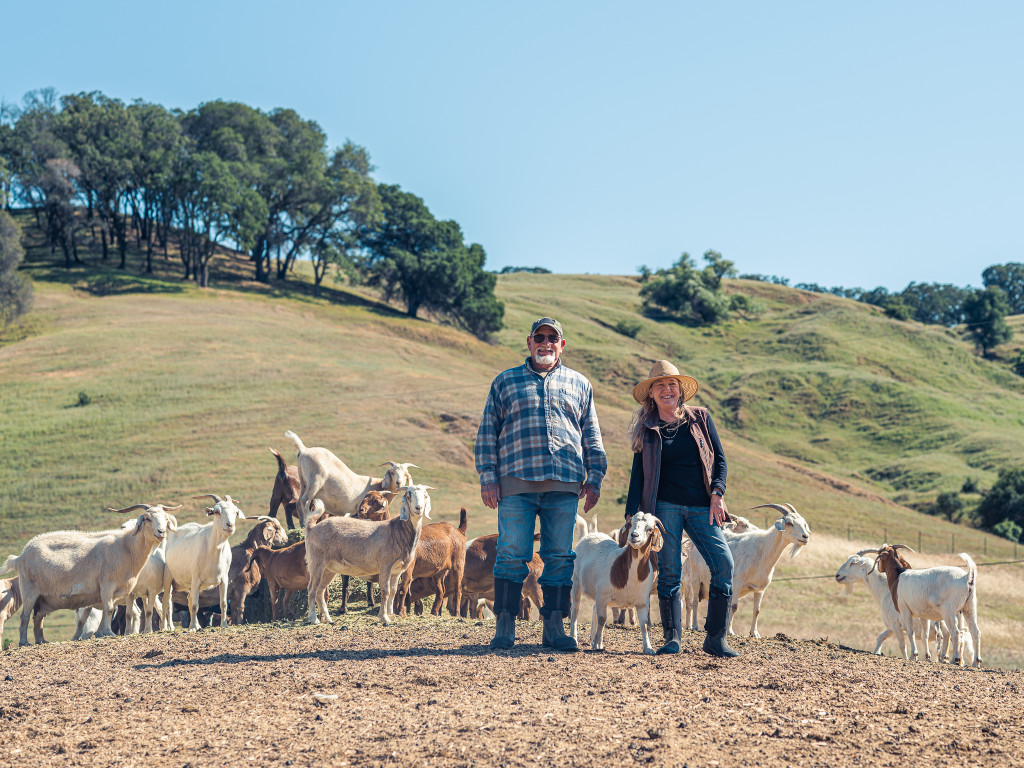
Dan and Liz Mcqueeney stand with their fire supression squad on the rolling hills of Napa
Dan and Liz McQueeney don’t look much like firefighters. Yet they are instrumental figures in the ongoing fight against Napa Valley wildfires.
Truth be told, they look a lot like farmers or ranchers. Any day of the week, you’re likely to find them wearing sturdy denim and tall boots, and Liz’s trademark wide-brimmed straw hat would be wildly out of place in any fire station.
If they look a lot like ranchers, there’s good reason for it: that’s what they are. And every day, week in and week out, they tend to some of Napa Valley’s most effective fire suppression units.
This is the story of the McQueeneys’ elite squad of fire suppression commandos. Or, as you and I would better recognize them, a whole tribe of goats.
Goats? Yes, Goats.
The McQueeneys own and operate a goat ranch, but these aren’t just your run-of-the-mill goats. They’re trained to do what they do best: eat everything in sight. Because while the rolling hills of Napa are incomparably beautiful, they’re also extremely flammable. Hazardous overgrowth becomes dangerous fodder during the dry season, and even a single spark could be enough to ignite the next wildfire in the region.
Keeping this hilly terrain free from hazardous overgrowth is a challenge that mechanical solutions don’t handle well. But goats? They don’t mind a bit. They’ll happily climb hills, cliff sides, and other impossible-to-reach locations and even more happily consume the hazardous overgrowth they see there.
Dan and Liz raise and tend to their elite goat squads, then lease them out to properties all around the Valley. It’s an effective business model that also works for the common good. It all depends on goats — and goats depend on water.
A Goat Story Is a Water Story
Raising goats requires a few things: food, land, and water. So any goat story is also a water story: the McQueeneys must provide an adequate, reliable water supply for their goats. In other words, goats need water to fight fires.
There are all sorts of challenges of running water systems on rural properties. First, farmers usually must source their own water via a well on the property. Then they must pump water into storage tanks, often located up a hill some distance from the well. They also need to distribute that water to all corners of the property.
In Dan and Liz’s case, they needed to ensure that their fire suppression squads always have access to drinking water. Spread that need across more than 700 acres of hilly terrain, and the challenges start to come into focus.
Goat-Friendly Terrain Creates Water System Challenges
The McQueeneys’ property — like so many farms and vineyards across Napa — is markedly hilly. They don’t have a line of sight from their home to the well. There are hills and valleys in between, which creates a problem for traditional water monitoring systems that rely on line of sight.
Not to mention, those traditional systems that only partially solve the McQueeneys’ water problems would cost $30,000 and up. That’s money that small ranchers like Dan and Liz can’t justify on a system that doesn’t fully solve their water challenges.
They also don’t have electricity running to all corners of their property— another factor that’s common among the 2 million rural farmers and ranchers in the US alone.
LoRa technology (on which meter.me is built) doesn’t require line of sight, making it an ideal solution for the McQueeney ranch. Every meter.mote in their system easily communicates with their meter.base base station, without the need for wired, wireless, or cellular connectivity.
Each meter.mote can be powered via AC power or local solar, too, meaning the McQueeneys don’t have to run electricity across long distances just to reach a remote sensor.
The McQueeneys also had a distance problem. Because of the layout of their property and its well placement, even getting to the well from the home took a physically demanding 25-minute ATV ride — one-way.
Meter.me Delivers Advanced Warning, Automatic Controls, and Better Measurements
Meter.me lets Dan and Liz monitor their well, valves, and water tanks from the comfort of their home. They can control valves and pumps remotely, and the platform’s automatic advance warning system tells the McQueeneys about water problems far sooner than they would’ve known through manual checks.
For the McQueeneys, meter.me already eliminates an hour’s work (minimum!) every time Dan would’ve previously needed to jump on the ATV and visit the well. It eliminates the related fuel costs, too.
But even more important for Dan, now entering his 70s, is mitigating the growing risk of bodily injury that comes from traversing hilly off-road terrain on an ATV multiple times a week.
And even more important for the couple’s flock of goats is avoiding the catastrophe of herd dehydration. Before meter.me, the McQueeneys had to balance the risk of running out of water against the risk and time commitment of yet another water tank check. Now, with meter.me, that kind of trade-off isn’t ever necessary. Dan and Liz know in near real time when something’s gone wrong, drastically reducing manual trips and checks while increasing the consistency of water availability for the goats.
Here’s what Dan had to say about his experience with meter.me: “We don’t do anything without meter.me now. Why would we? It saves me so much trouble every day. We used to run out of water all the time, but now I can check ahead and there are no more surprises. The well is far up the hill, so we can’t wait for the last minute to find out something is wrong!”
Less time-consuming manual work. Fewer water surprises. Consistent, reliable water availability for plants and animals. That’s the meter.me difference.